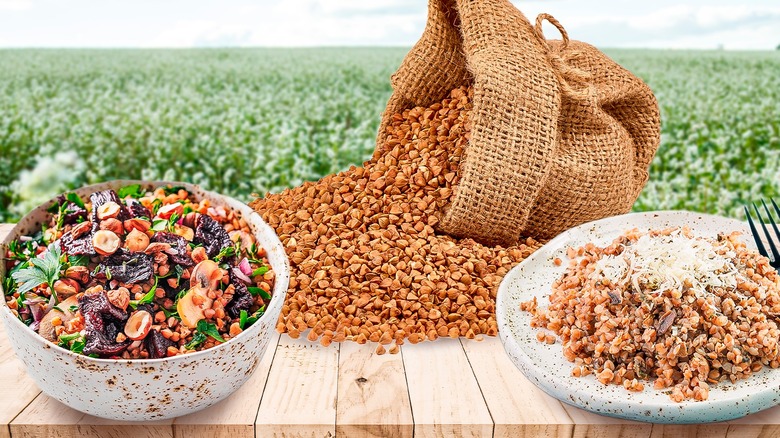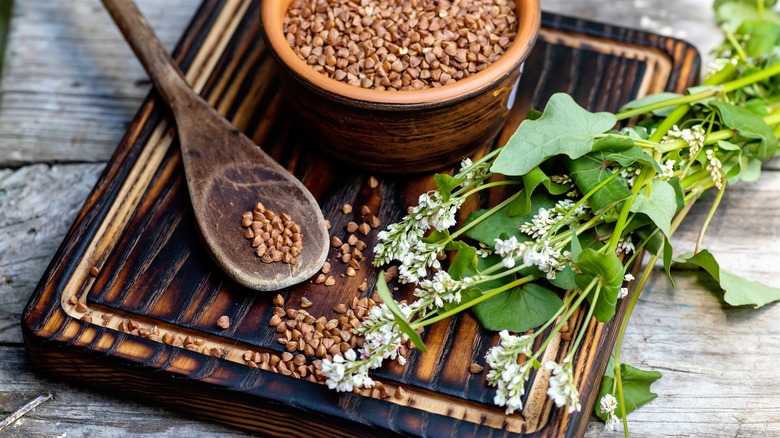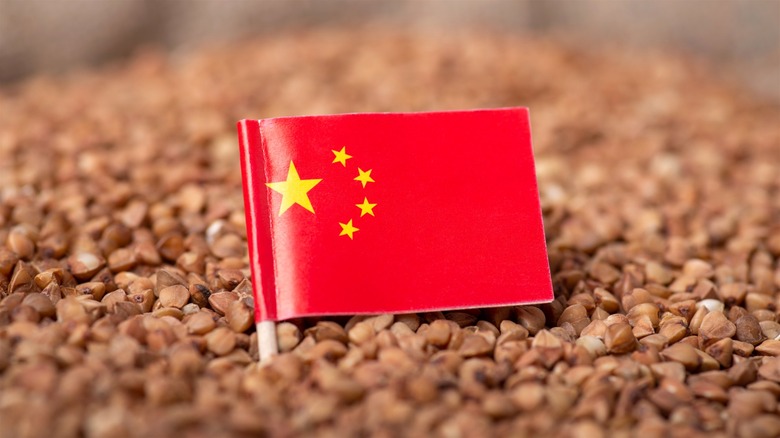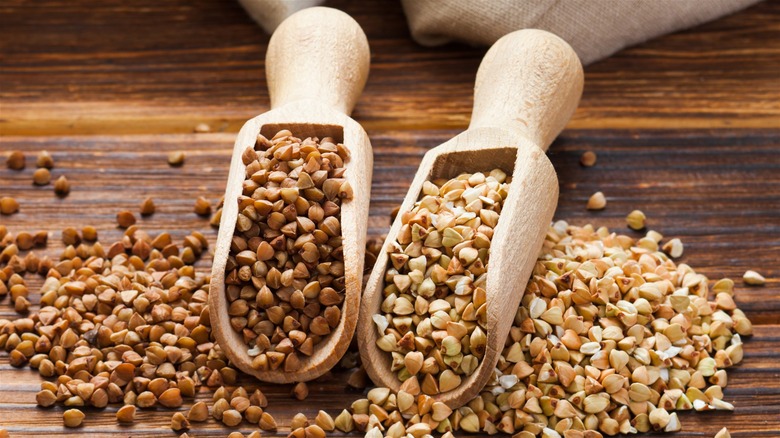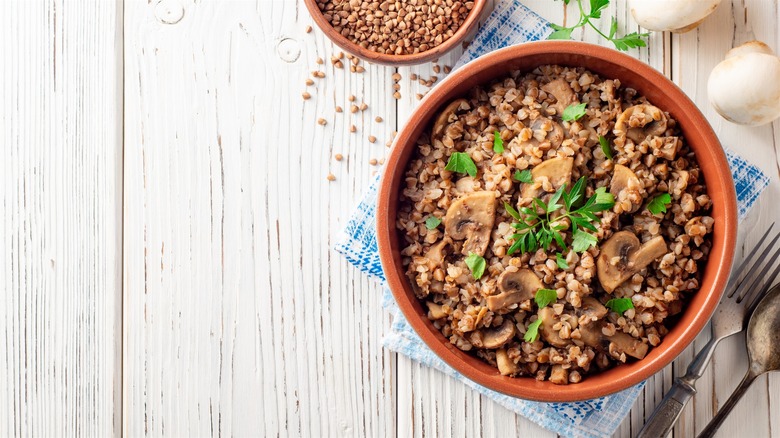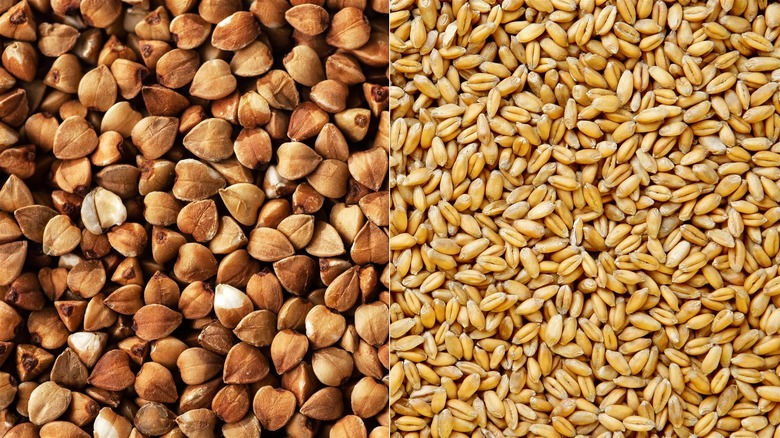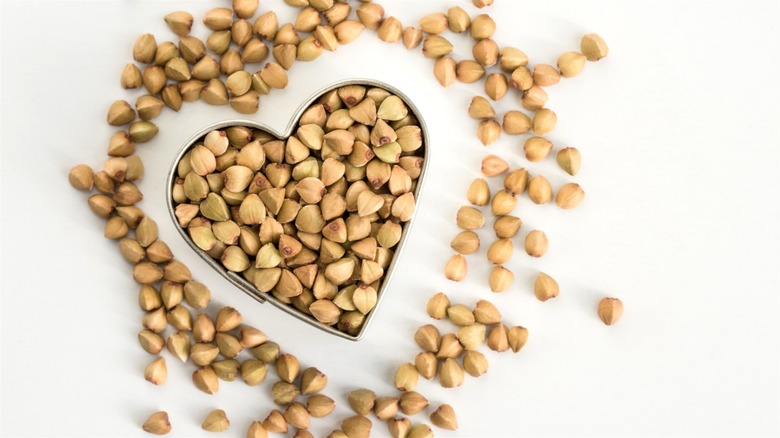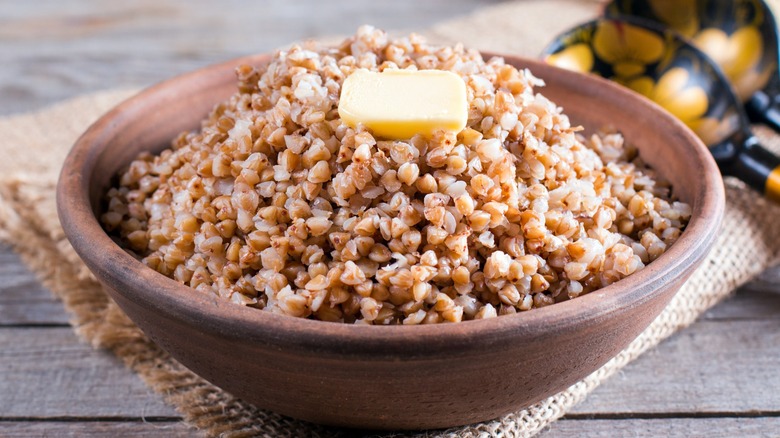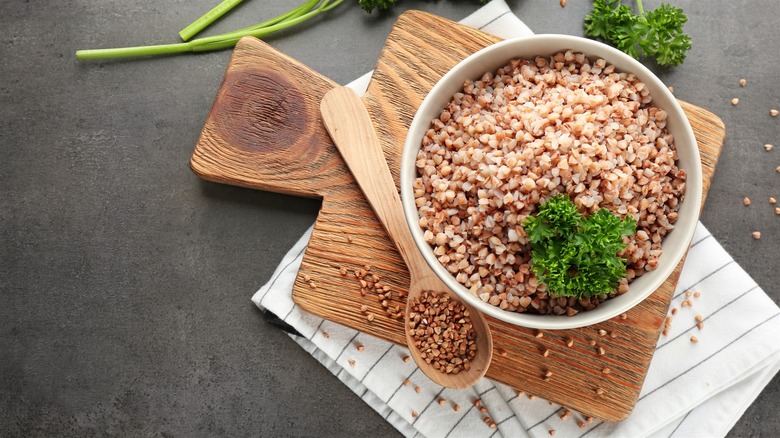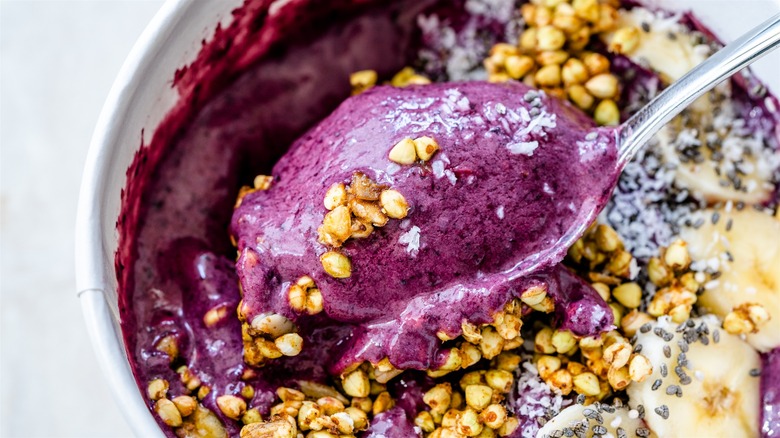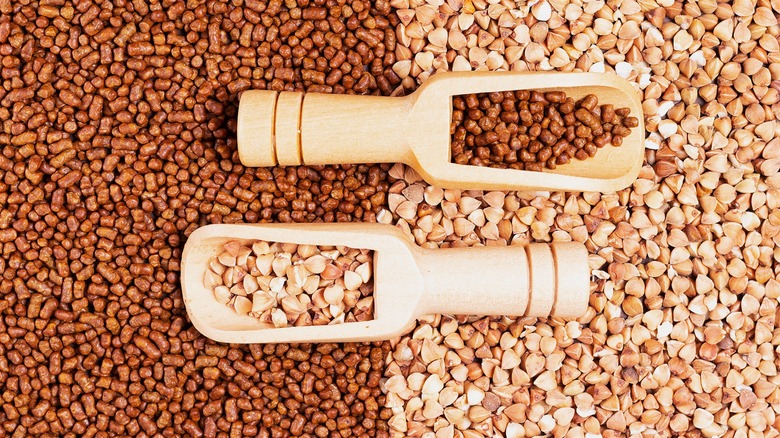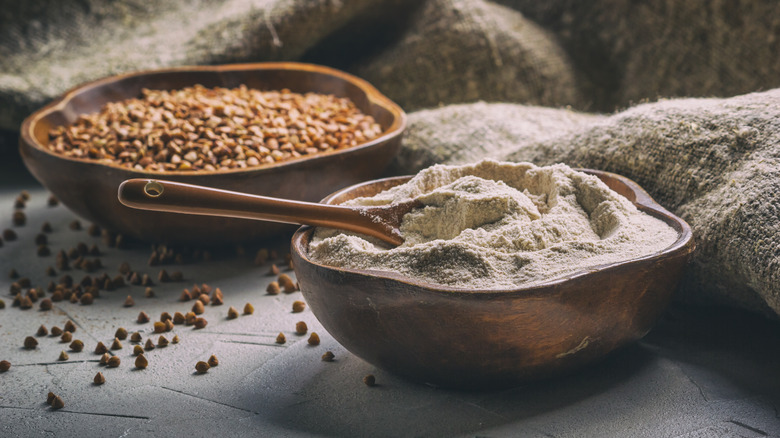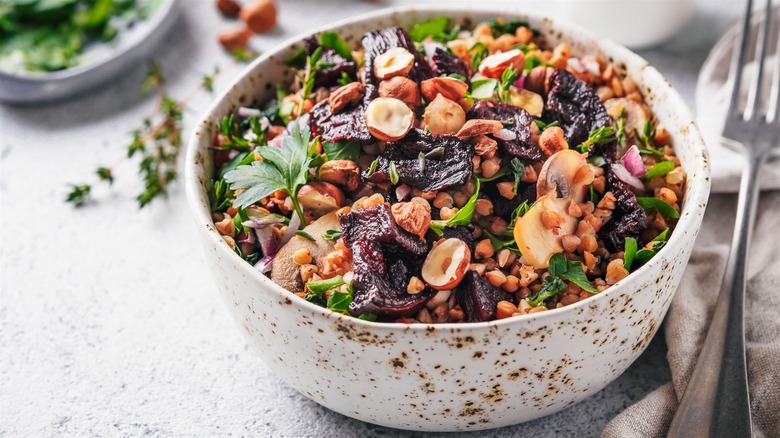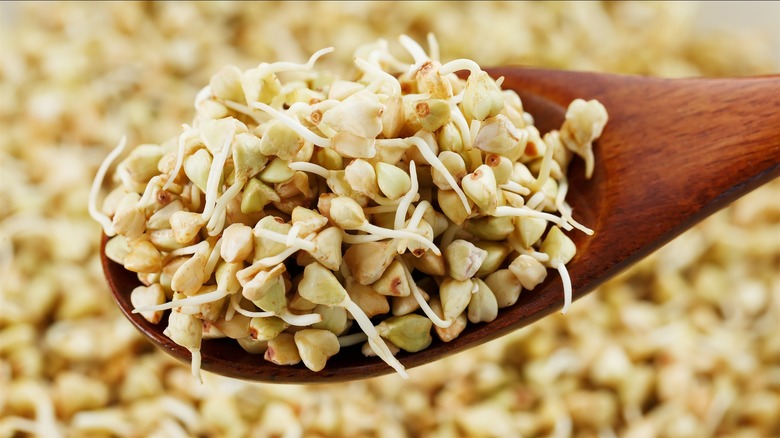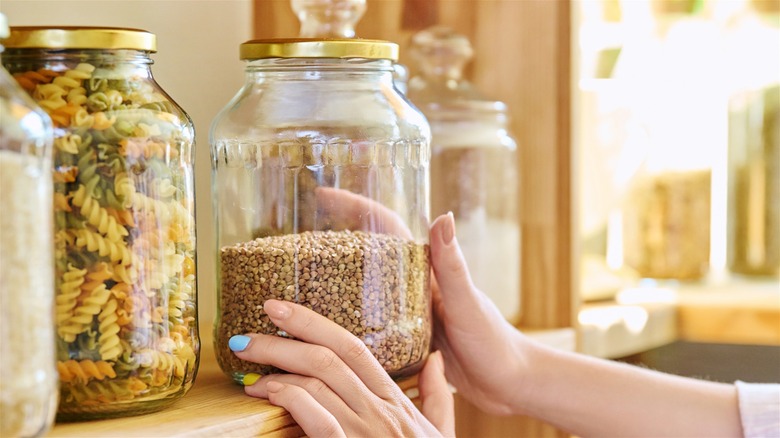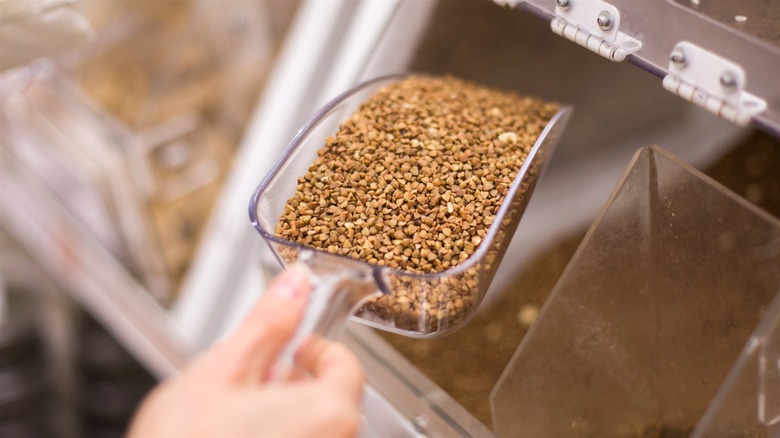Everything You Need To Know About Buckwheat
If you've tinkered with buckwheat flour or slurped soba noodles, it's time to get acquainted with the groats. This no-nonsense pseudo-cereal has carved a niche in global cuisines over the centuries, yet remains underutilized. Today, it's dubbed the "doomsday grain" in Eastern Europe, as it's the first thing people stock up on in times of economic or political instability. In the West, it is celebrated as a chic, health-conscious choice.
Buckwheat, in all its glory — whether it's the rich, nutty bravado of kasha or the subtle, earthy notes of its untoasted brethren — defies its wheat-implied lineage. Packed with a nutritional punch and lacking gluten, it's nature's gift to plant-based and gluten-free eaters alike. Whether tossed into a salad for a crunch, simmered into a risotto, or fermenting in a jar, buckwheat's culinary adaptability is unmatched. It's the everyday food for those ready to explore its magic without pretense.
What is buckwheat?
Often lurking in the health food aisle, buckwheat masquerades as a grain but is actually closer kin to sorrel and rhubarb than wheat. This imposter in the grain world is Fagopyrum esculentum, a plant that sports small, teardrop-shaped triangular seeds. Buckwheat belongs to the Polygonaceae family, which includes some edible wild plants such as Japanese knotweed and sheep's sorrel. Fortunately, buckwheat is a lot easier to come by, having been a staple long before it became a trendy superfood.
Known as a pseudocereal — akin to quinoa and amaranth — it's not just used as a grain substitute in cooking, but is also ground into gluten-free flour, a boon for the health-conscious and lovers of soba noodles alike. In the U.S., its superfood status may jack up the price, but in Eastern Europe, it's a humble, everyday food known as kasha. Beyond the kitchen, buckwheat plants are champions of agriculture. They battle weeds and enrich the soil, while their flowers are a bee favorite, providing a rich source of pollen and nectar, proving buckwheat's worth far beyond its nutritional value.
What are the origins of buckwheat?
Buckwheat, which most people have come to associate with Eastern European cuisines, surprisingly traces its origins back to Asia. It was most likely cultivated in China as early as the middle of the fourth millennium B.C. However, new linguistic evidence confirms that buckwheat was cultivated with barley long before millet and rice in eastern Bhutan. From China, it traveled to Korea, Japan, and India, eventually reaching northern Europe via Russia and Turkey during the late Middle Ages, and crossing into North America in the 17th century.
While this humble grain didn't build empires like wheat or rice, it became a life-saving staple in regions where harsh conditions thwarted more delicate cereals. Buckwheat's resilience in poor soil, rapid maturation, minimal pesticide needs, and soil-enriching qualities made it a critical rotational and emergency crop. Its cultivation was not just about filling bellies; it was about survival in unforgiving terrains. Today, Russia leads the global production, followed by China and Ukraine, with the U.S. trailing despite its minor cultivation footprint, primarily in states like North Dakota and New York.
What varieties does buckwheat come in?
The seeds of Fagopyrum esculentum, or common buckwheat, are transformed into two main products with distinct applications. Let's break them down. Raw buckwheat groats, with their light color and subtle flavor, have been minimally processed. They can be eaten raw, after soaking or sprouting, and incorporated in other dishes. As cooked grains, they can serve as a base for sweet and savory bowls. The roasted groats boast a richer, earthier flavor perfect for savory sides or stuffing, and are always eaten cooked.
Before exploring its culinary potential and health benefits, let's clarify its terminology. What's known as simply buckwheat in the U.S. is often labeled as raw or green buckwheat elsewhere. Meanwhile, the Russian word kasha, originally used to mean any porridge, somehow became synonymous with the roasted buckwheat groats in the States. But anyone familiar with this Eastern European pantry staple will tell you that buckwheat and kasha are different things. In Russian, the word "kasha" refers to the cooked dish, not the groats (which are known as grechka or grechnevaya krupa), so we'll keep these terms separate.
What does buckwheat taste like?
If you ever grab a raw buckwheat groat and bite into it, it might seem like there isn't much to write home about, flavor-wise. It will taste mild, grassy, and quite agreeable, verging on underwhelming. Toasting raw groats is highly recommended if you want to witness a miraculous transformation. Toasting them in a dry skillet promises to turn the flavor from medicinal and bland to a harmonious blend of grassy, fruity, and malty notes, enhancing the overall nuttiness. Toasted groats — whether store-bought or homemade — boast an undeniable plant-based charm.
In buckwheat-loving Eastern European countries, this pseudocereal is considered a rather neutral base for both fasting and meat-heavy meals. Yet despite its unassuming reputation and diet culture connotations, its aroma weaves a tale as intricate as a noir novel—nutty, smoky, with a welcome hint of fishiness. On its own, it might be an acquired taste — its bitterness and robust earthiness can be a jolt to palates accustomed to milder flavors of wheat, oats, or rice. But combining it with the right ingredients highlights its best features while downplaying the light bitterness.
Buckwheat vs. wheat
Despite the deceptive naming, botanically, wheat and buckwheat are worlds apart. The former, a staple grain from the grassy Triticum genus, is a cornerstone of global diets. It comes in a dizzying number of variations, from whole-grain berries to refined flour. The latter, on the other hand, hails from the flowering Fagopyrum genus, making it a pseudocereal with a lineage more akin to rhubarb than any grain. Its seeds, unlike wheat's familiar elongated, rounded grains, are small and triangular, reminiscent of 18th-century tricorne hats, and mainly come into our kitchens as groats.
While wheat enjoys universal acclaim, buckwheat shines in specific culinary applications, especially for those seeking gluten-free options or a lower glycemic index. Cooking times and nutritional profiles further distinguish these two. Buckwheat rarely requires more than half an hour (including resting time), while wheat berries can sit on the stovetop anywhere between 30 and 90 minutes. It also boasts a lower calorie count but doesn't skimp on nutrients, offering a bounty of magnesium and B vitamins. However, wheat berries and toasted buckwheat groats have some overlap in the way you'd use them – for example, as a base for comforting fall salads.
Is buckwheat healthy?
There's a reason buckwheat is considered a dietetic food in Eastern European countries. Its peasant roots and prominence in the strict Orthodox Christian fasting culture have also made it a universally revered food at times when you can't eat anything more lavish, yet need to keep yourself full and healthy. Lately, its nutritional appeal has slowly been creating a certain superfood air around it, particularly among those riding the waves of gluten-free and whole-food plant-based eating. So what makes buckwheat such a coveted health food?
For one, it's mostly slow-releasing carbohydrates, and its low GI helps avoid blood sugar spikes. Furthermore, it's a source of complete protein for vegans, and its fiber content aids digestion. But the true magic of buckwheat lies in its nutrients. It contains rutin and quercetin, which fortify blood vessels and combat inflammation, respectively. This mineral mine offers copper, manganese, magnesium, and phosphorus in every bite. Its significant iron content makes it an invaluable addition to the diets of plant-based eaters and menstruating persons, as both groups bear potential anemia risks. Finally, it's naturally perfect for the gluten-averse, though cross-contamination during processing still occurs.
What is buckwheat used for traditionally?
Russia is not just the biggest producer of buckwheat but also its most devoted consumer. There, grechnevaya kasha has been prominent on everyday tables since the 15th century. It's traditionally enjoyed as a plain side dish or elevated into a main with other ingredients, from sautéed onions and carrots to mushrooms and meat. Before rice came on the scene, it was used to stuff pies and cabbage rolls. You'll find buckwheat in other cuisines of the region — for example, Ukrainian fried buckwheat meatballs called hrechanyky, and the Ashkenazi Jewish buckwheat-pasta mix known as kasha varnishkes.
In India, buckwheat is often used during Hindu festivals. For example, eating grains is prohibited during the Navratri fast, so this pseudocereal saves the day. For example, kuttu ki khichdi, made from green buckwheat groats, includes kuttu, crushed roasted peanuts, potatoes, and warming spices. Fasting Hindus also use buckwheat flour for dosas and pancakes. In its native region, it's been milled into flour for ages — the Chinese have enjoyed buckwheat noodles since the 14th century. Buckwheat noodles eventually made their way over to Japan, transforming into slurp-worthy soba noodles by the 1600s.
How to cook buckwheat?
If your at-home experiences with buckwheat ended in a mushy disaster or an underwhelming, chewy outcome, perhaps you've been cooking buckwheat wrong the whole time. With just a few ingredients, you can master the art of cooking buckwheat to fluffy perfection in under 30 minutes. Whether you lean towards the subtly flavored raw variety or the robustly nutty toasted one, your preference will define the outcome. Buckwheat doesn't require soaking unless you're aiming for a raw vegan dish but always give it a good rinse.
Remember that the brown groats will better hold their shape in the pot, and the green ones might turn mushy. The solution? Buy pre-toasted kasha, or toss those pale groats you already own into the oven until they brown. The water ratio varies slightly (about 1:1.5 for green and 1:2 for brown groats), and a brief 15-20 minute simmer should follow. Keep the temperature low and the lid on during cooking until the water is absorbed, then leave your kasha to rest for another 10 minutes or more. Fluff it up, and don't shy away from mixing in some flavorful fat or a splash of soy sauce for an extra kick.
What can you cook with buckwheat at home?
Despite its traditional use as a basic porridge or a side dish, buckwheat has surprisingly many applications in modern home cooking. The unassuming groats travel from breakfast to dinner table seamlessly, so you could eat buckwheat every day if you wanted to.
In the morning, you can have a Slavic-inspired cereal bowl (kasha with milk) or bake raw buckwheat groats into a granola with cocoa and some type of syrup. Alternatively, soak them the night before, rinse well, and blend into a smoothie, or purée with lemon juice and a bit of sugar for a nondairy curd. For dinner, cook the groats like risotto, or use up leftover grains in a warm salad — serve it in a pretty bowl or stuff it into a roasted vegetable.
Soft, untoasted groats will add a welcome crunch to raw vegan sweets and protein bars. If you appreciate the nutty flavor, mix more than one form of buckwheat in a dish: For example, blend some raw groats into flour, add it to the cake mix, and caramelize the remaining groats to use as a topping.
Common vs. Tartary buckwheat
Unlike the familiar common buckwheat (Fagopyrum esculentum) that thrives in the temperate zones of the northern hemisphere, its lesser-known sibling, Tartary buckwheat (Fagopyrum tataricum) prefers the mountainous regions, such as the Himalayas. Self-fertile and highly cold- and drought-resistant, it produces elongated, teardrop-shaped seeds with a more complex flavor profile. It boasts all the same health benefits as common buckwheat, from immune-boosting quercetin and brain-healthy rutin (which Tartary buckwheat has exceptional amounts of, in comparison) to magnesium, iron, and assorted B vitamins. Basically, it's a new and improved buckwheat you should be on the lookout for.
When it comes to cooking, Tartary buckwheat flour can be used interchangeably with regular buckwheat flour, infusing dishes with its earthy taste and color and a slightly bitter edge (which can be softened with a sweetener). Its bran, intense in flavor and richer in protein than its common counterpart, brings most of its nutrients to the table when added to pancakes, cakes, and bread. This formidable, health-enhancing grain also comes in the form of delicious caffeine-free tea, known as memil-cha, kuqiao-cha, and soba-cha in Korea, China, and Japan, respectively.
What other products are made from buckwheat?
The groats' versatility goes far beyond their original form. So whether you're buckwheat's No. 1 fan or quite the opposite, consider experimenting with other products made from its nutritious seeds. For example, if you want more buckwheat breakfast options, look into its flaked or puffed varieties. They will make for smooth, satisfying porridge or a crunchy cereal bowl, ready in minutes. Their nutritional value is less impressive, but that's the price most of us pay for convenience.
The nutty gluten-free flour is perfect for anything from crêpes to bread. You can make it by pulverizing raw groats in a kitchen processor or buy it online and watch it elevate your chocolate chip cookies. Moreover, it has many savory applications. For a nutritious spin on porridge, seek out recipes for polenta taragna, a buckwheat-cornmeal dish hailing from Italy. And while making gluten-free buckwheat noodles from scratch might be challenging, Japanese soba, Korean naengmyeon, and numerous buckwheat pasta products are widely available for purchase. Finally, if you're feeling adventurous, you can turn buckwheat flour into a savory jelly, dressed with an umami-packed sauce — possibilities are endless.
What foods go well with buckwheat?
Despite its reputation as a health food, there's no law that says you have to eat buckwheat plain. In fact, its subtle, nutty, earthy flavor profile pairs well with plenty of daring ingredients. A classic move would be to sauté cooked toasted groats with onions and mushrooms, greatly enhancing their flavor and adding texture. Umami-packed miso paste, soy sauce, and seaweed are also welcome seasonings. Baking this humble side dish with some aged cheese and adding truffle oil elevates it to next-to-gourmet status, but mixing it with a jar of pesto will do in a pinch. Most nuts can be mixed in to highlight buckwheat's key flavor note, but pistachios do so most splendidly.
Buckwheat flour, in turn, pairs well with almonds — their sweetness offsets its lightly bitter edge, and you can experience this harmonious union by mixing the two gluten-free flours in any number of breakfast recipes or the rustic Italian torta di grano saraceno. Apples, lemons, and raisins can all be used to complement buckwheat baked goods. But if you appreciate tannins, seek out soba cha — Japanese buckwheat green tea noodles.
How do you sprout buckwheat?
You already know buckwheat is a nutritional powerhouse, but what if we told you there's a key to unlocking buckwheat's treasure trove of nutrients? If you've been waiting for a sign to get into the sprouting game, this is it — buckwheat is ridiculously easy to work with. The process is simple: Soak the raw green groats at room temperature for 20 minutes, initiate a drain-rinse-drain sequence, then leave them to germinate in a bowl or a jar with a sprouting lid for about eight hours, or overnight. The sprouting process will accelerate in a warm kitchen, or take a bit longer in a cold one. To minimize any health risks that come with sprouting, it is recommended that you cook or dehydrate the groats before eating.
Next, toss the cooked groats into a breakfast bowl, bake them into granola, or mill them into sprouted flour. A fan of homemade fermented drinks? Use the sprouted seeds to make rejuvelac, a beginner-friendly enzyme-packed concoction. Alternatively, take it one step further and germinate the groats for an additional few days for protein-packed buckwheat microgreens. Then, use them as a gentle edible garnish, which will add more personality to your meals (not to mention it'll earn you bragging rights).
How to store buckwheat
Navigating the storage of buckwheat requires a bit more than just tossing it into your pantry. Given its composition — rich in starch, protein, and notably higher in oil than most cereals — buckwheat's shelf life is a ticking clock, more susceptible to spoilage and the uninvited advances of pantry pests. Try explaining that it's a pseudocereal to a granary weevil — those creatures will attack any grain-type thing in your pantry, regardless of human classifications. Avoid that by transferring the seeds from store packaging to an airtight container (inspecting for signs of life and removing debris as you do). Labeling and dating these containers is a critical strategy to track expiration dates.
Buckwheat and its milled counterpart prefer a chilled life. Tucked away in the fridge, buckwheat can hang tight for about two to three months, while the freezer extends its lifespan to six months. Buckwheat flour, especially once the seal is broken, will last a month in the fridge or two in the freezer. However, if you're grinding your own buckwheat flour, you're playing a different game.
Where to buy buckwheat
Scouring the grocery store for buckwheat can feel like an adventure in itself. You're most likely to strike gold in the baking and cereal aisles, where buckwheat groats keep rice and beans company while buckwheat flour mingles with international or special dietary products. For a better price (and less packaging), search for it in bulk bins at zero-waste and natural food stores. If physical stores fail you, the digital world won't; Amazon and Walmart are treasure troves for buckwheat in various forms. A one-pound pack of buckwheat groats can easily be found on Amazon at $9.99. Walmart stocks Ukranian toasted groats at $24.99 per pound, but you could also get 10 pounds of raw groats for $53.40, and toast them yourself.
However, for the authentic kasha experience, a Ukrainian, Russian, or Polish store or a reliable brand from these regions ordered online will deliver the real deal. Avoid the health food aisle's raw, untoasted varieties unless you're prepared for a mushy outcome. Remember, the place of origin isn't just a label; it's a hallmark of quality and authenticity, especially when it comes to grechka.
Static Media owns and operates Tasting Table and Mashed.
